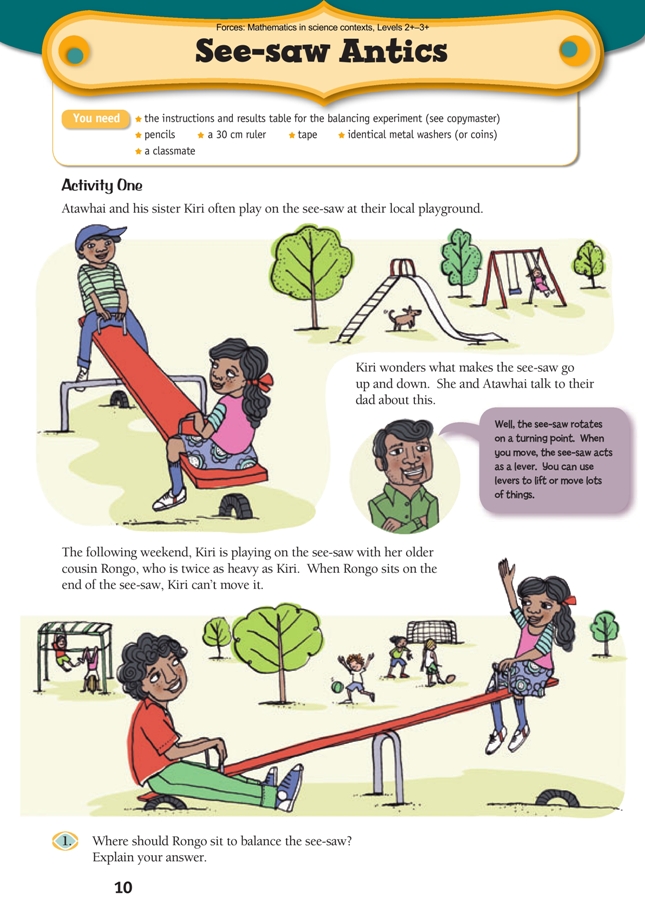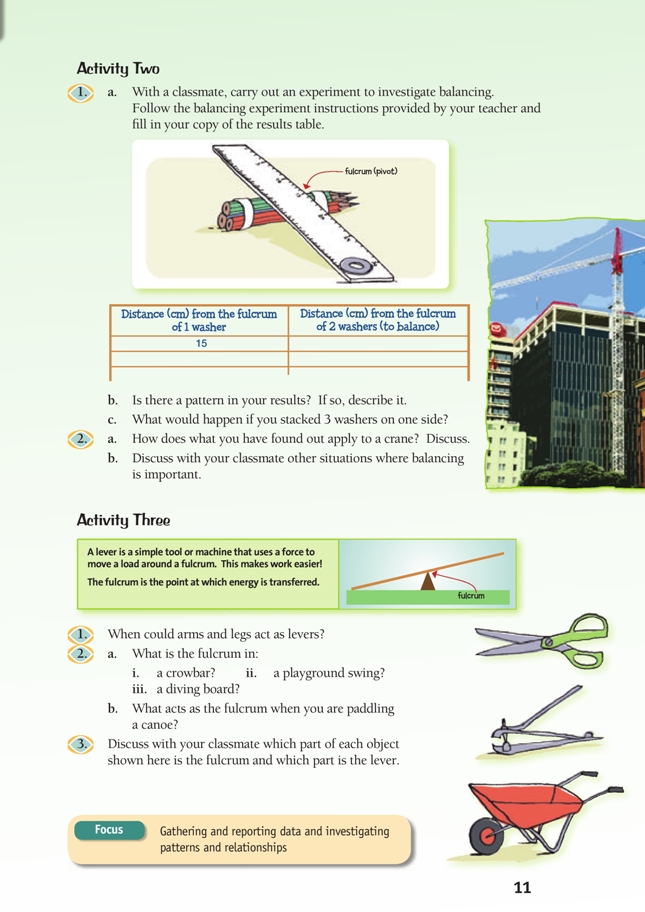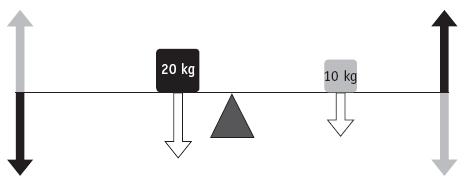This is a level (2+ to 3+) mathematics in science contexts activity from the Figure It Out series.
A PDF of the student activity is included.
Click on the image to enlarge it. Click again to close. Download PDF (907 KB)
Students will:
- gather and record data and use tables to identify patterns and relationships
- identify the relationship between the relative positions of the effort and load when balanced.
Students should discover that:
- turning force is a function of weight x distance from the fulcrum – in other words, the longer the lever arm, the less force is needed to lift a weight on the other side of the fulcrum
- the relationship between distance from the fulcrum of different weights is inverse (if there is twice as much weight on one side, it needs to be twice as close to the fulcrum to balance).
tape
identical metal washers (or coins)
pencils
the instructions and results table for the balancing experiment (see copymaster)
a classmate
FIO, Forces, Levels 2+-3+, See-saw Antics, pages 10 - 11
Activity One
Points of entry: Mathematics
Question your students about their mathematics strategies: How do you know where to put Rongo compared with Kiri if Rongo weighs twice as much as Kiri? Are you adding or multiplying to predict where to balance the see-saw? What if there are several children on each side of the see-saw: how would you arrange them so that they balance?
Introduce the idea of inverses*, for example, 2 and 1/2. The weight and the distance from the fulcrum are inversely proportional: if the weight on one side is double that of the weight on the other, it will balance it at half the distance from the fulcrum.
Although the students should use an informal scale for Rongo and Kiri, encourage them to quantify distance, for example, ask If Rongo is half a metre from the fulcrum, where should Kiri sit?
Points of entry: Science
Students will have prior knowledge of how see-saws work. Encourage them to think up their own
experiments: “What combinations of students will balance? Where? How could a see-saw be used to weigh things?”
Answers
Activity One
1. Rongo needs to move nearer the middle of the see-saw until he reaches a position where he and
Kiri balance each other. In order for the see-saw to balance, the turning forces on each side of the see-saw must be equal. (This means the distance from each child to the middle of the see-saw
multiplied by that child’s mass has to be the same.) If Rongo’s mass is twice that of Kiri, Kiri
needs to be twice as far from the fulcrum (see the diagram in Activity Two).
Activity Two
Have the students use light plastic or wooden rulers or they will get incorrect results when the fulcrum is not in the centre of the ruler because the different weights of the ruler on each side of the fulcrum would balance out some of the weight of the washers.
The position of washers on each side of a fulcrum will always be relative to the fulcrum. Watch out for students who might be moving the washers and the fulcrum in order to fi nd balance. This will result in measurement error. Avoid such measurement errors by asking the students not to move the fulcrum during their investigation. The turning force (often called torque) is always dependent on the distance from the fulcrum as well as the weight.
Note that force and turning force are not the same. Turning force is force x distance. What this means is that a small weight on one side of a fulcrum can balance a large weight on the other side of the fulcrum if their turning force is the same, but their weights (and corresponding force of gravity) will still be different.
Points of entry: Mathematics
This activity revolves around the idea of equality of products. Ask the students how they will work out where to place multiples of washers (weights). For example, If you have 3 washers on one side and 1 washer on the other, how do the distances compare?
It’s important that the students realise that they need to measure distances from the fulcrum, not from the end of the ruler. Question your students about where the “zero” on the scale of the see-saw or ruler is. In other words, If you put the washer on the 30 centimetre mark, are you interested in the distance from zero or the distance from the fulcrum?
Points of entry: Science
The science language and concepts in this activity will be new to students: exposure to a wide range of experiences is one of the aims of the key competency of using languages, symbols, and texts.
Activate what the students have learned about force and differentiate between force and turning force. Have them consider this unbalanced situation:
The force of gravity (weight) on the masses on both sides of the fulcrum is the same, but the turning force is not.
This activity defines fulcrum and the simple lever machine. Simple machines transfer the location and/or the direction of a force. Ask How does a lever change the direction of a force? Simple machines include the wheel and axle, screw, pulley, lever, and wedge or inclined plane. Ask: How is a lever like a pulley? How does a screw change the direction of a force?
Deepen the students’ thinking about forces by having them draw diagrams showing the relative size and direction of forces. In the diagram that follows, the white arrows indicate the force of gravity, the black arrows indicate the turning force of the 20 kg weight, and the grey arrows indicate the turning force of the 10 kg weight. Notice that the turning forces are equal, and therefore the see-saw is balanced, because the 10 kg weight is twice as far from the fulcrum as the 20 kg weight.
Answers
Activity Two
1. a. Practical activity. Your table should look similar to the table below if you are using a 30 cm ruler with the fulcrum in the middle (at 15 cm). The second column illustrates the pattern by showing the distance from the fulcrum of 2 washers.
| Distance (cm) from the fulcrum of 1 washer | Distance (cm) from the fulcrum of 2 washers (to balance) |
| 15 | 7.5 |
| 10 | 5 |
| 5 | 2.5 |
| 4 | 2 |
b. The single washer will be twice as far from the fulcrum as the 2 washers. In other words, distance from the fulcrum x weight (washers) is the same on both sides.
c. When 3 washers are used on one side, they are placed 1/3 of the distance from the fulcrum compared with the single washer.
2. a. To balance a long crane arm, the counterweight on the shorter side must be heavier than the load being lifted. The turning force of the counterweight x the length of the short arm has to equal the length of the load arm x the load.
b. Answers will vary. Examples might include a balance beam or balancing on a high wire at the circus, a scale for measuring weight, the axle of a trailer towed by a car or truck, or the keel of a sailing boat.
Activity Three
Points to note
The fulcrum of a lever isn’t always obvious. For example, a fi shing rod is a lever where the fulcrum is the end of the handle, the effort is on the handle, and the load is on the tip. It’s easier to visualise this when the person fi shing is in a harness and the butt of the rod is secured. A shovel is a lever where the fulcrum is in different positions depending on how it is used. For example, if you’re using a shovel to lift a load, the back hand is the fulcrum.
Points of entry: Science
Levers are classified by the relative positions of load (weight), fulcrum, and effort. If the load is on one side of the fulcrum and the effort is on the other, it’s a class one lever, like a see-saw. Class two levers have the fulcrum on one end and the effort on the other, for example, a stapler. Class three levers have the fulcrum on one end, the load on the other, and the effort in the middle, like a pair of tongs.
Challenge the students to identify other situations that use levers and fulcrums and ask them to come up with examples for the different classes of levers. The students will need to listen actively to each other and build on others’ ideas. The key competency relating to others involves recognising when to compete and when to co-operate.
Answers
Activity Three
1. Arms and legs act as levers when kicking a ball, boxing, dancing, swimming, and so on. When you lift anything, the tendons and muscles in your arm cause your bones to act as levers, with your joints as fulcrums.
2. a. i. When pulling out a nail, the fulcrum is at the bottom of the u-bend. When used as a lever, the fulcrum is wherever you support the bar (by resting it on something).
ii. The fulcrum is the 2 hinges at the top where the swing pivots.
iii. A diving board has its fulcrum at the end connected to the stand.
b. The fulcrum of a canoe paddle is the point where the paddle is in the water (which is why the blade of a paddle is wide – the width slows the movement of the paddle in the water so that the boat moves forward; think about what it would be like paddling with a stick!).
3. The fulcrum for each object is:
- scissors: at the bolt where the two blades connect
- nail clippers: at the kink in the top lever; at the opposite end of the second lever
- wheelbarrow: at the axle of the wheel.
The levers for each object are:
- scissors: one blade and handle
- nail clippers: the part you push down and the top part of the cutter
- wheelbarrow: the strut from the wheel to the end of the handle.




